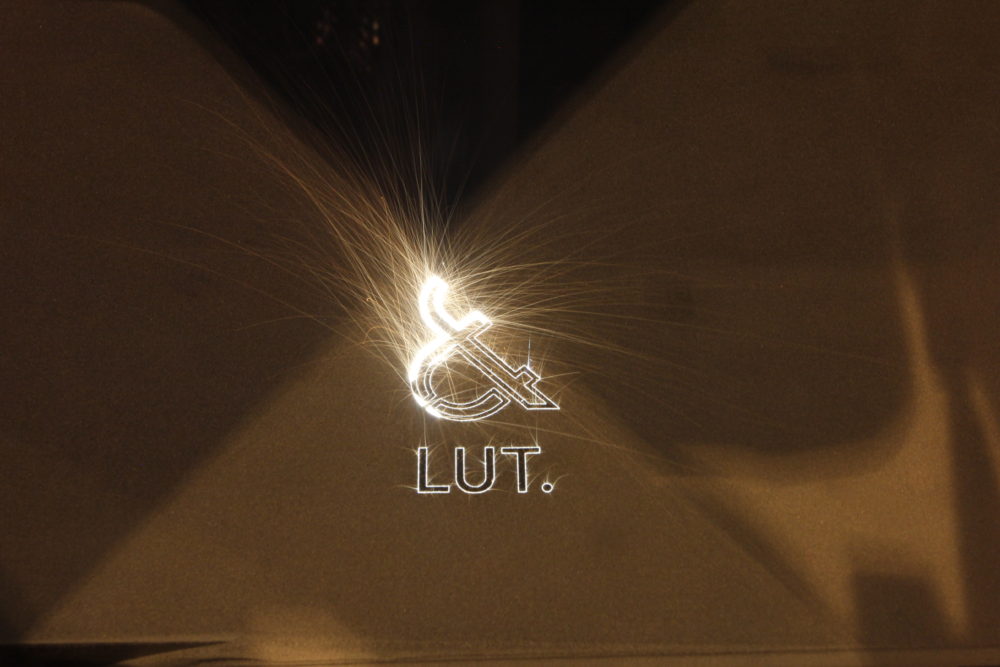Anna Huusko
LUT-yliopistossa panostetaan 3D-tulostukseen ja sen koulutukseen -Tarkoituksena on pysyä Suomen lisäävän valmistuksen kärkiyliopistona tulevaisuudessakin
Anna Huusko · ·

Yliopiston hallituksen päätöksen taustalla investoida toiseen metallien
3D-tulostuslaitteistoon on LUT-yliopiston yli kymmenen vuoden mittainen tutkimustyö lisäävästä valmistuksesta ja 3D-tulostamisesta. Vuonna 2011 saadun ensimmäisen laitteiston kanssa on tehty paljon niin akateemista kuin teollista tutkimusta.

Uusi tulostin odottaa käyttöönottoa
Tutkimustyön lisäksi vuonna 2012 LUT-yliopistossa alkoi lisäävän valmistuksen ja 3D-tulostuksen liittyvä opetus sekä koulutus. ”Tällä hetkellä lisäävän valmistuksen opetusta on kandidaattityöntekijöille, diplomi-insinöörivaiheessa oleville opiskelijoille sekä jatko-opiskelijoille eli väitöskirjaa tekeville opiskelijoille. ”dosentti Heidi Piili kertoo.
Nyt perustutkintokoulutuksessa on 160 opiskelijaa ja jatkokoulutuksessa 10. ”Vuosien 2020-2024 aikana on valmistumassa 10 väitöskirjaa aiheesta.” Piili jatkaa. Perusopetustyön lisäksi LUT-yliopistossa on tarjottu runsaasti erilaisia teollisuudelle suunnattuja koulutuksia. ”Voidaan sanoa, että LUT-yliopistolla on tarjolla yksi laajimmista koulutus-ja opetusvalikoimista koko Suomessa.” Piili täsmentää.

Dosentti Heidi Piili esittelee 3D-tulostettua muistitikun kuoria.
LUT-yliopistossa lisäävästä valmistuksesta ja 3D-tulostuksesta on tehty kuluneen 10 vuoden aikana yli 70 tieteellistä julkaisua ja yli 30 opinnäytetyötä. “Tavoitteemme on, että voisimme tekemämme tutkimuksen ja teollisen yhteistyön avulla olla Suomen numero niin tutkimuksessa kuin opetuksessa ja samalla toimia yhteiskunnallisena tiennäyttäjänä 3D-tulostuksessa.” Piili kertoo.

Yhtenä onnistumisen edellytyksenä ovat hankkeet, joiden avulla tutkimusta pystytään viemään laajamittaisemmin ja syvällisemmin eteenpäin. ”Hankkeiden avulla mahdollistetaan yhteistyö niin kotimaisen kuin kansainvälisen teollisuuden kanssa, jotta tutkimustulokset saadaan implementoitua laajasti. Yhtä tärkeä aspekti hankkeissa on yhteistyö kotimaisten ja ulkomaisten opetus- ja tutkimuslaitosten kanssa, jotta hankkeille saadaan myös suora yhteys opetus- ja tutkimustoimintaan. ”Piili jatkaa.
LUT-yliopistossa on tällä hetkellä menossa useita 3D-tulostukseen liittyviä hankkeita, kuten Strategisen tutkimuksen neuvoston rahoittamana Valmistus 4.0-hanke (MFG4.0), EAKR-rahoitteinen Teollisuuden 3D tulostus (Me3DI)-t&k -hanke, ESR-rahotteinen Chief Expert in Engineering (CEE)-koulutushanke, EIT Raw Materialsin rahoittama PRE3DACC-esikoulutushanke, SAFIR2022:n rahoittama Additive manufacturing in nuclear plants-t&k-hanke, Business Finlandin rahoittama New Art of Reason (Newarea)-t&k-hanke ja Suomen Akatemian rahoittama Re-GoldAM-tutkimushanke.

3D-tulostukseen liittyviä hankkeita on useita. Vaikka niiden tematiikka on samansuuntainen, kohderyhmä ja tavoitteet ovat erilaiset, jolloin eri hankkeissa tehdyt toimenpiteet täydentävät toisiaan. “Jo hankesuunnitelmia tehdessä on pyritty siihen, että tutkimusta ja kehitystyötä pystytään tekemään samanaikaisesti monella rintamalla niin akateemisessa kuin teollisessa mielessä. Tällä tavoin myös hankkeiden tuloksia saadaan laajemmin implementoitua, kun mukana on niin kotimaisia kuin kansainvälisiäkin hankkeita.” Piili täsmentää.
Hankkeiden eri kohde- ja sidosryhmien avulla tutkimustuloksia myös saadaan laajemmin esille. “Usein onnistuneiden projektien tuloksena voidaan saada uusia lähtöjä eri tutkimus- ja kehityshankkeisiin sekä -aktiviteetteihin.”Piili kertoo. “Yliopiston yhtenä tehtävänä on kuitenkin olla yhteiskunnallinen vaikuttaja niin yleisesti käytävässä keskustelussa kuin näyttää myös suuntaa tutkimuksessa.” Piili muistuttaa.
MFG4.0 Presentations at the July international conference Knowledge Management in Organisations (KMO2019)
Anna Huusko · ·

Mikkel Stein Knudsen Project Researcher, Finland Futures Research Centre, University of Turku
In the middle of the Finnish summer, the Finnish MFG 4.0 research team of Finland Futures Research Centre contributed to the annual international Knowledge Management in Organisations-conference which this year was held in Zamora, Spain. MFG 4.0-researchers presented two papers, chaired a special session, and acted as part of the conference organizing committee.
In July 19, MFG4.0 work package leader
Dr. Jari Kaivo-oja and researcher Mikkel Stein Knudsen (both Finland Futures Research Centre, University of Turku) represented the project at the annual Knowledge Management in Organisations-conference with topics highly relevant for MFG 4.0 research challenges.
The MFG 4.0 presented two papers, one a conceptual paper on Digital Twins and one on a bibliographic study of emerging technologies enabling Manufacturing 4.0.
Conference papers were:
Jari Kaivo-oja, Osmo Kuusi, Mikkel Stein Knudsen & Theresa Lauraeus (2019) Digital Twins Approach and Future Knowledge Management Challenges: Where We Shall Need System Integration, Synergy Analyses and Synergy Measurements?
Mikkel Stein Knudsen, Jari Kaivo-oja & Theresa Lauraeus (2019) Enabling Technologies of Industry 4.0 and Their Global Forerunners: An Empirical Study of the Web of Science Database.
Both contributions were published in high profile series of the Springer, Conference proceedings. Knowledge Management in Organizations, 14th International Conference, KMO 2019, Zamora, Spain, July 15–18, 2019, Proceedings. See MORE
Notes from MFG4.0-workshop: Dos and Don’ts of Big Data for Foresight
Anna Huusko · ·

Mikkel Stein Knudsen, Project researcher Manufacturing 4.0, Finland Futures Research Centre, University of Turku
Organisations today, whether public or private, are trying to figure out how to capture new opportunities through application of Big Data. For forward-looking organisations this might be one of the most pressing concerns of the ongoing digital transformation. It is often considered an important strategic imperative to succeed, yet we have found many organisations to be struggling with how to even approach the subject.
Increased integration of Big Data can also lead to better foresight-models in organisations, research and society. This could be an important step towards better decision-making in general. Identifying good practices of Big Data for Foresight is therefore a topical research topic to tackle in order to make Finland thrive in an era of rapid change. How to integrate Big Data into Foresight-methodologies is also an important and highly topical research question for the academic foresight and futures research community.
MFG4.0 Research Team Members visited the Committee of the Future Coordinators at the Parliament of Finland
Anna Huusko · ·

MFG 4.0 researchers from the University of Turku, Research professor, Research director Jari Kaivo-oja and Senior Researcher Theresa Lauraéus met the coordinators of Finland Futures Committee at the Parliament of Finland, On Thursday 22.9.2019. There was a joint meeting of the Finland Futures Research Centre, FFRC (University of Turku) and the Future Committee of Finland, which was organized in Helsinki. Co-hosts of the event were the Committee Counsel Olli Hietanen and Senior Advisor from the Committee for the Future, Parliament of Finland, Dr Maria Höyssä.
According to Senior Adviser Maria Höyssä FFRC will be invited later in the autumn to give its formal statement for the Committee for the Future on emerging future issues that the Committee should explore. But before that there will be an informal brainstorm on themes that the researchers of FFRC think would be interesting for the Committee to look into. This is a possibility to bring forward and collectively comment on the tentative ideas and weak or silly signals, from the juniors and seniors alike.
It is important for MFG4.0 project to have high-level policy dialogues on many levels. This special day in the Parliament of Finland was a very good example of this kind of constructive dialogues. The new Government of Finland was shortly informed about the MFG4.0 project. Research director and research professor Jari Kaivo-oja proposed to the Committee of the Future to pay strategic attention to the digitalization process and new industrial policy options of Finland. As a concrete initiative, he proposed to start futures-oriented co-creation and co-planning process of the Finnish industries and the Government, in which “full business potential of Manufacturing 4.0 and Industry 4.0 will be discussed with implementation programs in the Parliament of Finland”.
- « Go to Previous Page
- Go to page 1
- Interim pages omitted …
- Go to page 7
- Go to page 8
- Go to page 9
- Go to page 10
- Go to page 11
- Interim pages omitted …
- Go to page 18
- Go to Next Page »







